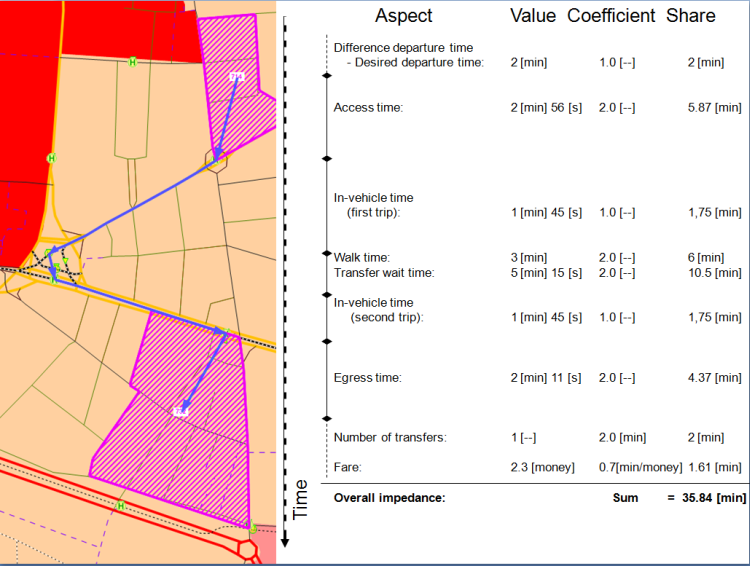An impedance function generally measures the effort connected to a traffic process. All instances are summarized to this effort, which prevent participants from carrying out this process and therefore create an impedance. Effort examples are especially time and costs connected to the process. You can also enter subjective criteria in the impedance. Thus, the impedance of a certain connection in the PuT may increase if certain comfort criteria are not satisfied.
Impedance functions play an important role in several impact models. In the assignment, the impedance function assigns a route or connection an effort. In PrT, especially the journey time in the loaded network flows into the impedance, but it can also be additional properties such as traveling expenses and possible toll. For dynamic assignments, it is also the discrepancy between the departure time and the desired departure time. In PuT, in addition to the travel time, it is mainly the number of transfers and the fare which have an effect on the impedance.
A problem for impedance functions is that completely different aspects are included and have to finally arise from conjoint evaluation in form of a number. These different aspects which are partially measured in different units, must therefore be recalculated and weighted against each other. In general, weighting of the factors for different groups of assessing personnel is different. For this reason, impedance functions for example can be defined at the assignment per demand segment (Using Visum: Definition and application of volume-delay functions) and at line blocking per vehicle combination (Using Visum: Parameters of the line blocking procedure).
In Visum, impedance functions are used in the following contexts:
- Assignment (impact model): The impedance function assigns the effort to each path, thus depending on the type of assignment, each route or connection, which the traveler has to make if he or she decides to take this path. The most natural criterion is the travel time which has the corresponding unit time [s]. Especially in PrT, the travel time of a link is not constant, but depends on the volume, the coherence is described in a VD function.
- Demand models (User model): Within the framework of trip distribution, mode choice, as well as combined procedures for trip distribution and mode choice, the impedance function allocates an OD pair or the mode choice for this relation to the effort, which has to be overcome for this choice. In this context we are traditionally talking about utility functions. Although the supporting concept is identical, the benefit of it is, however, only the negative impedance of the process.
- Line blocking (operator model): The impedance function assigns each activity (vehicle journey, empty trip, layover, etc.) in a cycle the effort, which arises if the activity is performed by this cycle. The most natural criteria here are the costs.
Despite these different application areas, the impedance function structure is always the same: Each impedance function consists of a sum, in which each summand evaluates a certain aspect of the effort and is weighted by a coefficient (see Illustration 67). To calculate the impedance of a traffic process, the properties of the process are first determined regarding each aspect. Each aspect is then evaluated separately, in PrT especially by evaluating the VD function. This evaluation of individual aspects is then provided and summed up with the weighting factors.

Illustration 67: Impedance calculation for a PuT connection, for clarity illustrated in the unit [min]

